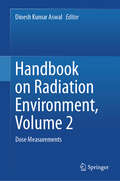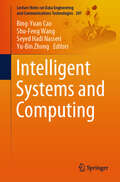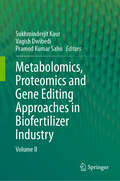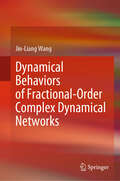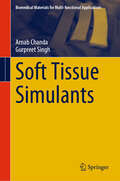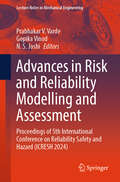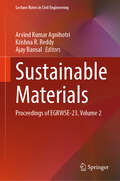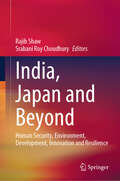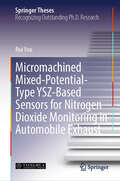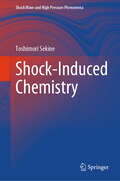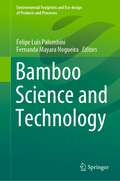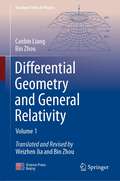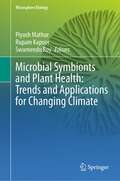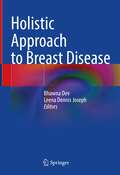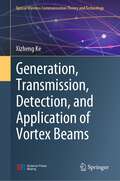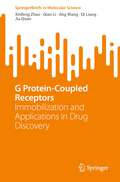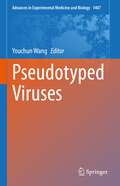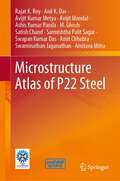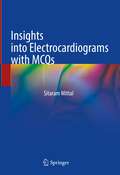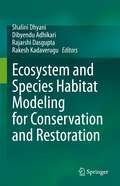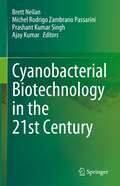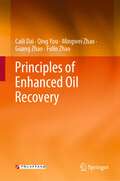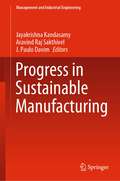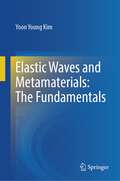- Table View
- List View
Handbook on Radiation Environment, Volume 2: Dose Measurements
by Dinesh Kumar AswalThe handbook aims to provide a comprehensive resource for understanding ionizing radiation dosimetry, catering to experts, policymakers, and interested readers. The content of the handbook is focused on two main aspects of dose measurements: external dosimetry and internal dosimetry. The section on external dosimetry covers fundamental principles and discusses monitoring techniques across various environments, such as nuclear, industrial, research, and medical facilities. It also covers advanced topics like Bayesian inference and retrospective dosimetry. The internal dosimetry section explores radionuclide biokinetics, simulation techniques, dose evaluation, and monitoring methods. Specific scenarios, such as radon inhalation and off-normal conditions, are addressed, highlighting the importance of precision and intervention. The handbook serves as a comprehensive resource for students, academicians, scientists, engineers, and policymakers interested in seeking an in-depth knowledge of radiation dose measurements and its multi-faceted aspects in protecting human health and the environment.
Intelligent Systems and Computing (Lecture Notes on Data Engineering and Communications Technologies #207)
by Bing-Yuan Cao Shu-Feng Wang Seyed Hadi Nasseri Yu-Bin ZhongThis book includes high quality research papers submitted at the 2022 “Four Session (ICFIE, ICORG, GDORS, CGHMORS) Celebration” Joint International Conference held on December 28, 2022 and the online meeting of the Fuzzy Information and Engineering Branch of the China Operations Research Society on September 17, 2022. It covers topics in the fields of certainty, stochastic uncertainty, and fuzzy uncertainty, including computer science and mathematics, operations research and control, artificial intelligence, information and engineering technology, barrier-free communication for people with disabilities, digital logistics and knowledge representation, medical applications, queuing theory and game theory, algorithms and optimization methods. The book is a valuable reference book for scholars, engineers, management professionals, and graduate, undergraduate, and vocational students interested in computer science, mathematics, and fuzzy mathematics and operations research, as well as their applications in information technology and engineering.
Metabolomics, Proteomics and Gene Editing Approaches in Biofertilizer Industry: Volume II
by Pramod Kumar Sahu Vagish Dwibedi Sukhminderjit KaurBiofertilizer refers to the live or latent microbial inoculants capable of enhancing plant growth through direct and indirect mechanisms. This book covers strategies for harnessing the integrated technologies, omics, proteomics, and metabolomics for the development of potential novel biofertilizers. Modern techniques for enhancing the efficacy and quality of biofertilizers has been discussed in detail. Increasing crop productivity poses a great challenge due to increasing global population and researchers are looking for solutions to this using sustainable approaches. Biofertilizers play an imperative role in enhancing yield production in crops and this book covers detailed account of biofertilizers on a single platform. It also provides guidance on sustainable ways of increasing crop production and helps in generating ideas to formulate collaboration between public and private sectors for future innovation in the field of biofertilizers.This book is especially designed for the research graduates, young researchers and scholars who are directly involved in the research-related activities of the biofertilizers. It can also be useful to professors, lecturers, biotechnologists, biofertilizer production specialists and other stakeholders associated with strain improvement for biofertilizer development.
Dynamical Behaviors of Fractional-Order Complex Dynamical Networks
by Jin-Liang WangThis book benefits researchers, engineers, and graduate students in the field of fractional-order complex dynamical networks. Recently, the dynamical behaviors (e.g., passivity, finite-time passivity, synchronization, and finite-time synchronization, etc.) for fractional-order complex networks (FOCNs) have attracted considerable research attention in a wide range of fields, and a variety of valuable results have been reported. In particular, passivity has been extensively used to address the synchronization of FOCNs.
Soft Tissue Simulants (Biomedical Materials for Multi-functional Applications)
by Gurpreet Singh Arnab ChandaSoft tissue simulants, essential for automotive and ballistic testing, medical, and surgical training, have traditionally relied on cadavers and animal tissues. However, their biomechanical properties change with time due to dehydration after death and the biomechanics of the animal models cannot be translated and compared with the human tissues. This book compiles various synthetic tissues used in these applications, addressing their characterization and industry-wide applications. While older simulants lack biofidelity, recent advancements in biofidelic soft tissue simulants offer promising alternatives, yet technology transfer remains limited. This book fills the gap by exploring each simulant's characteristics and current trends, facilitating their adoption in clinical and academic settings. These synthetic tissues have the potential to replace live tissues in surgical training, streamlining biosafety approvals. They also benefit academic researchers by reducing costs and time in biomechanical testing. Anticipated to be the first of its kind, this comprehensive reference book will showcase recent advancements in soft tissue simulant development, serving as a cornerstone text in tissue engineering & biomedical engineering, medical simulation, biomechanics, and related fields.
Advances in Risk and Reliability Modelling and Assessment: Proceedings of 5th International Conference on Reliability Safety and Hazard (ICRESH 2024) (Lecture Notes in Mechanical Engineering)
by Prabhakar V. Varde Gopika Vinod N. S. JoshiThis book presents the proceedings of the 5th International Conference on Reliability Safety & Hazard-2024, held in Mumbai during February 21–24, 2024. It covers the latest advances in artificial intelligence and machine learning in development of risk-conscious culture. Various topics covered in this volume are reliability prediction, precursor event analysis, fuzzy reliability, structural reliability, passive system reliability, digital system reliability, risk-informed approach to decision making, dynamic PSA, uncertainty and sensitivity modeling, among others. The book is a valuable resource for researchers and professionals working in both academia and industry in the areas of complex systems, safety-critical systems, and risk-based engineering.
Sustainable Materials: Proceedings of EGRWSE-23, Volume 2 (Lecture Notes in Civil Engineering #509)
by Krishna R. Reddy Arvind Kumar Agnihotri Ajay BansalThis book contains peer-reviewed and selected papers presented during the International Conference on Environmental Geotechnology, Recycled Waste Materials and Sustainable Engineering (EGRWSE) 2023, held at NIT Jalandhar. It discusses the recent innovations, trends, concerns, practical challenges encountered, and the solutions adopted in waste management and engineering, geotechnical and geoenvironmental engineering, infrastructure engineering and sustainable engineering. This book can serve as a useful resource for researchers, educators, policymakers, and professionals working in the field of civil engineering, chemical engineering, environmental sciences, and public policy.
India, Japan and Beyond: Human Security, Environment, Development, Innovation and Resilience
by Rajib Shaw Srabani Roy ChoudhuryJapan–India relations have traversed from "distantly friendly" to "indispensable partners." The significant development of the India-Japan strategic partnership, the convergence of bilateral strategies, and the addressing of broader economic relations and cultural dimensions signify that bilateral relations have entered a "new era" in Japan-India relations. Given the region's emerging geopolitics, diplomatic relations between these two nations have gained momentum beyond the traditional pillars of engagement. New dimensions, namely, human security, environment, disaster risk reduction, climate change issues, innovation, and resilience building have gained currency. Addressing these, this book covers the broader aspects of human security dimensions of India-Japan collaboration. Involving multi and trans-disciplinary research, including in-depth reviews and new data based on case studies from India and Japan, this book sheds light on new convergence frontiers between these two nations. Furthermore, the book suggests specific policy and action measures to enhance human security through the bilateral cooperation between India and Japan, which has a global impact.
Micromachined Mixed-Potential-Type YSZ-Based Sensors for Nitrogen Dioxide Monitoring in Automobile Exhaust (Springer Theses)
by Rui YouThis book presents original methods to facilitate the development of micro-mixed-potential-type nitrogen dioxide sensors, especially in the following aspects: (i) improvement of sensing performance of electrodes; (ii) enhancement of chemical activity of reaction interface; (iii) development of advanced flexible low-power-consumption mixed-potential-type YSZ-based nitrogen dioxide sensors. Miniaturized sensors have steadily emerged into the commercial marketplace as competitive alternatives for monitoring and controlling the pollution gas in automobile industry. Despite the great potential, the real-world applications for most conventional micro-nitrogen dioxide sensors are still limited due to insufficient sensitivity, unacceptable cost, and the lack of robustness under harsh environmental disturbances. To address the issue, micro-nitrogen dioxide sensors based on mixed potential solid electrolyte is an ongoing area of great academic and technological interest. This book is expectedto be a guide for researchers on the way forward to chase future horizons in the fields of instrumentation, electrochemistry and micro/nano-electronics.
Shock-Induced Chemistry (Shock Wave and High Pressure Phenomena)
by Toshimori SekineThis book begins with the history and background of the subject and then describes key experimental methods. Subsequent chapters are devoted to individual topics of chemistry and materials, namely, synthesis of hard materials, ceramics at high pressure, shock-induced chemical operations, biomolecules, meteorites, and metals and molecules under extreme conditions. Lastly, it offers applications to earth and planetary science and ends with future perspectives. Shock waves dynamically produce high pressure and temperature conditions and offer interesting areas for studies on unique chemical reactions. This book introduces readers to modern shock-induced chemistry and its applications and provides an update of topics in that discipline. Readers can gain a comprehensive understanding of current shock-induced chemistry and its versatile applications.
Proceedings of the 7th International Conference on Materials Engineering and Nanotechnology 2023: Innovative Approach and Recent Developments in Materials Engineering & Nanotechnology (Springer Proceedings in Physics #1068)
by Cong Wang Ching Yern CheeThis book includes selected peer reviewed articles presented at the 7th International Conference on Materials Engineering and Nanotechnology 2023 (ICMEN 2023) held on 04-05Nov at Kuala Lumpur in Malaysia. It highlights recent innovative approach and developments in materials engineering and nanotechnology fields. A broad range of topics and issues in modern materials science and nanotechnology are discussed, including advanced materials synthesis and characterization, nanoscale science and engineering, functional composite and nanomaterials, sustainable materials and green technologies. The importance and relevance of these proceedings lie in their contribution to the scientific community's collective knowledge and understanding of materials science/engineering and nanotechnology. By disseminating cutting-edge research findings and innovations, these proceedings foster collaboration, inspire new ideas, and push the boundaries of scientific discovery. Given its scope, this book will be of interest to a wide readership, including materials and nanotechnology engineers, scholars and researchers in science, technology and engineering disciplines.
Bamboo Science and Technology (Environmental Footprints and Eco-design of Products and Processes)
by Felipe Luis Palombini Fernanda Mayara NogueiraBamboo is one of the most sustainable materials in nature due to its fast growth, rapid regeneration, outstanding mechanical properties, and applications in numerous industries. Latest technological advances have been allowing the plant to be studied and applied to exciting new projects. Being bamboo an icon of sustainable development, this book approaches the latest developments in the study of the plant, either as a natural resource or as a source of inspiration for more efficient designs. With the global urging demand for more sustainable practices, innovations in bamboo science and technology are key to the development of environmentally sound solutions.
Differential Geometry and General Relativity: Volume 1 (Graduate Texts in Physics)
by Canbin Liang Bin ZhouThis book, the first in a three-volume set, explains general relativity using the mathematical tool of differential geometry. The book consists of ten chapters, the first five of which introduce differential geometry, which is widely applicable even outside the field of relativity. Chapter 6 analyzes special relativity using geometric language. In turn, the last four chapters introduce readers to the fundamentals of general relativity. Intended for beginners, this volume includes numerous exercises and worked-out example in each chapter to facilitate the learning experience. Chiefly written for graduate-level courses, the book’s content will also benefit upper-level undergraduate students, and can be used as a reference guide for practicing theoretical physicists.
Microbial Symbionts and Plant Health: Trends and Applications for Changing Climate (Rhizosphere Biology)
by Piyush Mathur Rupam Kapoor Swarnendu RoyThis book provides a comprehensive understanding of the complex relationship between microbial symbionts and plants in the era of climate change. It focuses on the plant microbiome associated with different plant organs like roots, leaves, stems, fruit, and seeds, and showcases their significant role in the enhancement of crop yield and protection in a sustainable manner. Concomitantly, acumens to the most emerging trends in plant microbial research that includes rhizosphere engineering and metagenomics are also covered in this title. The association of microbial symbionts with the host offers a wide advantage in terms of acclimatization to varied environmental conditions. A large number of microbes such as cyanobacteria, PGPR, endophytes, and AMF have been shown to improve plant growth and production under the effect of various abiotic and biotic stresses. These microbial symbionts secrete several secondary metabolites, signaling molecules, and hydrolytic enzymes that play a multifarious role in improving plant growth and yield. Moreover, the symbionts have been known to regulate the host responses at the molecular level. Bioprospecting these microbial symbionts will provide an alternative to the chemical-based fertilizers and pave the path for the development of biofertilizers. The book is a suitable reading material for undergraduate and postgraduate students, researchers, and scientists working in the field of agricultural biotechnology, microbiology, mycology and plant pathology, and allied fields of plant and microbial sciences. The book in this context attempts to provide an integrative and exhaustive study as well as research material that would help the scientific community in wide respect.
Holistic Approach to Breast Disease
by Bhawna Dev Leena Dennis JosephThe book covers the entire gamut of breast diseases including all necessary dimensions, such as radiology, pathology, surgery and oncology. It provides a complete spectrum from clinical scenario, imaging investigations and interventions, final histopathological diagnosis and complete treatment plan from medical, surgical and radiation to follow up protocols. It discusses about common and uncommon varied breast diseases encompassing all necessary specialties. It includes stepwise pictorial descriptions of ‘must know’ in breast lesions. It presents high resolution images of the latest technologies in radiology and pathology based on typical case scenarios. The book features special chapters on recent updates and innovative technologies used in imaging, pathology and management of breast diseases. It contains line diagrams and flow charts for quick reading and easy understanding, to be practically implemented as and when required in any concerned specialties.The book is useful for consultants in radiology, pathology, general surgeons, onco-surgeons, super specialists and fellows in breast diseases, and postgraduates in these fields.
Generation, Transmission, Detection, and Application of Vortex Beams (Optical Wireless Communication Theory and Technology)
by Xizheng KeThis book focuses on the key technologies supporting orbital-angular-momentum multiplexing communication: generation, transmission, detection, and application of vortex beams. A series of methods for generating vortex beams are described and compared in detail. Laguerre-Gaussian and Bessel-Gaussian beams are taken as examples to introduce the transport properties of vortex beams in atmospheric turbulence. The authors show that superposition of vortex beam state, interference, diffraction, and grating can realize the detection of the topological charge of vortex beams. The authors also introduce the application of vortex beams in optical communication and the transmission characteristics of partially coherent vortex beams in atmospheric turbulence. Finally, the authors describe vortex beam information exchange and channel reconstruction.
G Protein-Coupled Receptors: Immobilization and Applications in Drug Discovery (SpringerBriefs in Molecular Science)
by Xinfeng Zhao Qian Li Jing Wang Qi Liang Jia QuanThis book summarizes the progress made to functional immobilize G protein-coupled receptors (GPCRs) through site-specific or orientated recognition in both non-covalent and covalent manners. The last decade is the dawn of the “post-structural biology” era for G protein-coupled receptor research. As an emerging approach for state-of-the-art immobilization, this book discusses efforts to explore the elegance of naturally-occurring biochemical reactions by using their high specificity and robust reactivity in the complex system, such as site-specific conjugation by covalent recognition between enzymes and their substrates. With the perspective of protein-drug interactions, this book also reviews the applications of protein immobilization, with an emphasis on G protein-coupled receptors, in drug discovery and protein-ligand interaction analysis. In addition, the merits, opportunities and disadvantages are analyzed for different immobilization methods, and a perspective for future directions is presented. Given its scope, this book appeals to a broad readership, particularly researchers engaged in the field of analytical chemistry, bioconjugate chemistry, and chemical biology, and other related field, as well as teachers of relevant majors in colleges and universities.
Pseudotyped Viruses (Advances in Experimental Medicine and Biology #1407)
by Youchun WangThis book intends to report the new progress of pseudotyped viruses, including the construction of pseudotyped viruses with different strategies or vectors for most important viruses. Especially for emerging viruses, optimization of the condition and parameters for assay development based on the pseudotyped viruses and widely application as surrogate of authentic virus to study the biological functions of virus, detection of neutralizing antibody, screening viral entry inhibiters, and others. It includes most pseudotyped viruses that have the protein of the target virus on the surface of the parent virus with incomplete genome. The book is likely to be of interest to all researchers in the field of virology, vaccine, and anti-viral drug development and evaluation.
Microstructure Atlas of P22 Steel
by Rajat K. Roy Anil K. Das Avijit Kumar Metya Avijit Mondal Ashis Kumar Panda M. Ghosh Satish Chand Sarmishtha Palit Sagar Swapan Kumar Das Amit Chhabra Swaminathan Jaganathan Amitava MitraThis book highlights the qualitative and quantitative sequential changes in microstructure of P22 steel under various stress and temperature conditions. The P22 alloy is an established material used under elevated temperature and stress for the components of thermal power plants. Temperature and stress levels for laboratory experimentation have been selected based on the true operating condition of a boiler. This book describes both continuous as well as interrupted tests that were performed under given parameters. Subsequently, the microstructures, bulk hardness and NDE parameters (magnetic and non-linear ultrasonic) have been evaluated. For reliable data, the microstructures have been observed at different regions of creep exposed samples by different characterization techniques. This has been further followed by drawing correlation between specific features like precipitate size variation with creep strain / creep time and so on. Given the contents, this book will be a useful reference for researchers and professionals working in the area of materials especially in thermal power plants.
Insights into Electrocardiograms with MCQs
by Sitaram MittalThe present is bundled with several unique features. It provides up-to-date information on electrocardiograms for almost all electrocardiographic abnormalities covers all aspects of surface electrocardiography in detail. Summaries follow all book chapters for quick revision and MCQs for self-assessment. This book will be helpful to clinicians, fellows in medicine preparing for different careers in cardiology, and ECG technicians and their teachers.The purpose of writing this book - While teaching undergraduates, postgraduates in general medicine, and students of diploma course in cardiac instrument technology, I realized that the students did not have the knowledge of basic concepts of electrocardiography and did not know the clinical significance of various abnormalities. Students, therefore, felt that the subject was difficult to understand and of no clinical significance. Students, therefore, did not feel interested. There was a need for a book that could simplify the subject to the ground level for a beginner who does not know even the basics of electrocardiography. Most of the books in this field are targeted towards cardiologists with an understanding that the reader already has enough knowledge of the basic concepts of electrocardiography. MCQs are the cornerstone for learning, teaching, and evaluation. None of the books in the market gives the idea of MCQs in electrocardiography. What problem does this book solve for the readers? - This book explains various normal and abnormal findings with the help of diagrams and illustrative electrocardiograms. Clinical implications of multiple abnormalities are discussed. This makes the subject easy to understand and to interest for a beginner. MCQs will help the readers in self-assessment. MCQs will also help teachers and examiners in evaluating the students.
Ecosystem and Species Habitat Modeling for Conservation and Restoration
by Shalini Dhyani Dibyendu Adhikari Rajarshi Dasgupta Rakesh KadaveruguThis edited book is focused on SDG 15. This volume covers aspects of species and ecosystem modeling in understanding the complexity of ecological systems, restoration, protected area management, and species conservation. The book follows a systematic and situation-sensitive approach to discuss ecosystem and species modeling tools, approaches, science, case studies, opportunities, and gaps for enhancing conservation efforts, ensuring ecosystem resilience, and addressing sustainability issues. The book emphasizes on science, innovations, case studies, and strategic relevance as main pillars of using ecosystem and species modeling tools and implementing the outcomes and results. In addition, clear conceptual frameworks, elaborated methodologies, and their applications are included to support policy planning and interventions to reduce and reverse human encroachment in human-dominated natural ecosystems, their degradation, and loss of important species and ecosystem services. Essential information with a special focus on advances and opportunities in advancing the implementation of results and outputs of the modeling tools, challenges and constraints for addressing loss of ecosystem services, designing and implementing sustainable landscape restoration, environmental risk assessment, and finally understanding policy implications and concerns for mainstreaming modeling results in conservation planning and decision-making is included in the book. Further topics include ultimate translational value of modeling tools and efforts across transitional ecosystems and species habitat to provide better evidence to influence the nature-based solutions (NbS) and ecosystem health assessment using Red List of Ecosystems (RLE). The emerging roles of integrative socio-ecological as well as techno-cultural factors in promoting the relevance of ecosystem and species modeling is one of the key features of this book. This edited volume is of interest and useful to researchers, students, scholars, policy makers, forest managers, consultants, and policy makers in the fields of protected area management, forest department, conservation, modeling, climate change, and sustainability science, and also authors engaged in IPBES, IPCC, and several other assessments.
Cyanobacterial Biotechnology in the 21st Century
by Brett Neilan Michel Rodrigo Zambrano Passarini Prashant Kumar Singh Ajay KumarThis book covers recent advances in cyanobacterial research. It deals with diversity, evolutionary biology, stress physiology, molecular biology of stress responses, and biotechnology of this group of prokaryotes. Cyanobacteria are ubiquitous and, undoubtedly, agriculturally microorganisms in terms of carbon and nitrogen fixation. In addition, cyanobacteria have long been used to fertilize crops and are a source of protein for humans. In parallel with the advances in cyanobacterial research in the 21st century, the development and application of innovative techniques in molecular biotechnology has widened the spectrum of commercial applications and potential exploitation of cyanobacteria. This book will be of interest to both new and experienced researchers involved in cyanobacterial molecular biology, ecology, and industrial biotechnology. This collection of chapters from experts also serves as essential reading for undergraduate and graduate students of to understand the importance of cyanobacteria in agriculture, ecology, microbial physiology, and environmental sciences.
Principles of Enhanced Oil Recovery
by Caili Dai Qing You Mingwei Zhao Guang Zhao Fulin ZhaoThis book presents the latest progress in enhanced oil recovery technology and introduces the application of various enhanced oil recovery methods in oilfield development. Enhanced oil recovery (EOR) is a continuous theme in oilfield development. Due to the influence of geological conditions, development mode and physical and chemical factors, more than half of the proven oil reserves remain underground and cannot be accessed. Therefore, many enhanced oil recovery methods have been developed to achieve higher oil recovery. This book presents the basic principles and provides the chemistry knowledge related to enhanced oil recovery. It also expounds the applicable criteria of chemical agents. In addition, combined with field application examples, the limitations of existing enhanced oil recovery methods are analyzed, and the future development direction of enhanced oil recovery technology is highlighted. It is worth noting that the integral profile control and water shutoff technology in this book is widely recognized in the enhanced oil recovery industry and has achieved remarkable economic benefits. Given its scope, this book is useful for the scientific and technical personnel engaged in the study of oil recovery chemistry and enhanced oil recovery and also as a teaching reference for teachers and students majoring in petroleum engineering and oilfield chemistry.
Progress in Sustainable Manufacturing (Management and Industrial Engineering)
by Jayakrishna Kandasamy Aravind Raj Sakthivel J. Paulo DavimThis book provides recent developments in sustainable manufacturing ranging from product designing to product delivery. It focuses on key challenges and solutions at various stages such as product design, material selection, material processing, manufacturing and energy consumption to ensure sustainability at every stage of product lifecycle. It further offers solutions to build sustainable product by responsible consumption and production. The role of advanced technologies in sustainable manufacturing is also covered in this book. Given the topics covered, this book will be useful for the researchers and professionals working in the area of mechanical engineering, especially industrial and production engineering.
Elastic Waves and Metamaterials: The Fundamentals
by Yoon Young KimThis book serves as an introductory text for students and engineers with limited knowledge of metamaterials (and elastic waves). This text begins with the most straightforward vibrating systems, such as single and 2-DOF spring-mass systems. It examines the observed phenomena in 2-DOF systems in an unconventional manner to prepare the reader for research on metamaterials. After presenting wave phenomena in an infinitely connected spring-mass system, an elastic bar, a continuous version of an infinite system, is analyzed. This instructional strategy, which progresses from the discrete model to the continuous model, facilitates efficient comprehension of wave and metamaterial concepts. Using continuous and discrete one-dimensional models, bending waves and their manipulation through metamaterials are also discussed. In the latter chapters of this book, advanced readers are introduced to the fundamental wave phenomena in two-dimensional media and wave manipulation using metamaterials, such as mode-converting transmission. As wave phenomena are the fundamental phenomena in vibrating structures, those interested in acoustics and vibration would gain a great deal of knowledge from this book, as the material covered in it offers a very different perspective on oscillatory phenomena than what is typically found in books on acoustics and vibration. Because this book presents a new technique for manipulating waves using metamaterials, engineers and scientists who work with (ultra)sounds and structural vibrations would find it very useful for expanding their knowledge of relevant topics.
